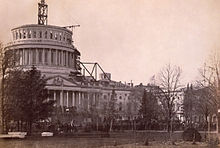38th United States Congress
| 38th United States Congress | |
|---|---|
|
37th ←
→ 39th
|
|

United States Capitol (1861)
|
|
| March 4, 1863 – March 4, 1865 | |
| Senate President | Hannibal Hamlin (R) |
| Senate Pres. pro tem |
Solomon Foot (R) Daniel Clark (R) |
| House Speaker | Schuyler Colfax (R) |
| Members | 52 Senators 184 Representatives 10 Non-voting members |
| Senate Majority | Republican |
| House Majority | Republican |
| Sessions | |
|
Special: March 4, 1863 – March 14, 1863 1st: December 7, 1863 – July 4, 1864 2nd: December 5, 1864 – March 3, 1865 |
|
The Thirty-eighth United States Congress was a meeting of the legislative branch of the United States federal government, consisting of the United States Senate and the United States House of Representatives. It met in Washington, D.C. from March 4, 1863, to March 4, 1865, during the last two years of the first administration of U.S. President Abraham Lincoln. The apportionment of seats in the House of Representatives was based on the Eighth Census of the United States in 1860. The Senate had a Republican majority, and the House of Representatives had a Republican plurality.
The Confederacy fielded armies and sustained the rebellion into a second Congress, but the Union did not accept secession and secessionists were not eligible for Congress. Elections held in Missouri and Kentucky seated all members to the House and Senate for the 38th Congress. Elections held among Unionists in Virginia, Tennessee and Louisiana were marred by disruption resulting in turnouts that were so low compared with 1860, that Congress did not reseat the candidates with a majority of the votes cast.
The count below identifies party affiliations at the beginning of the first session of this Congress, and includes members from vacancies and newly admitted states, when they were first seated. Changes resulting from subsequent replacements are shown below in the "Changes in membership" section.
During this Congress, two seats were added for each of the new states of Nevada and West Virginia, thereby adding four new seats.
Before this Congress, the 1860 United States Census and resulting reapportionment changed the size of the House to 241 members. During this Congress, one seat was added for the new state of Nevada, and three seats were reapportioned from Virginia to the new state of West Virginia.
...
Wikipedia
